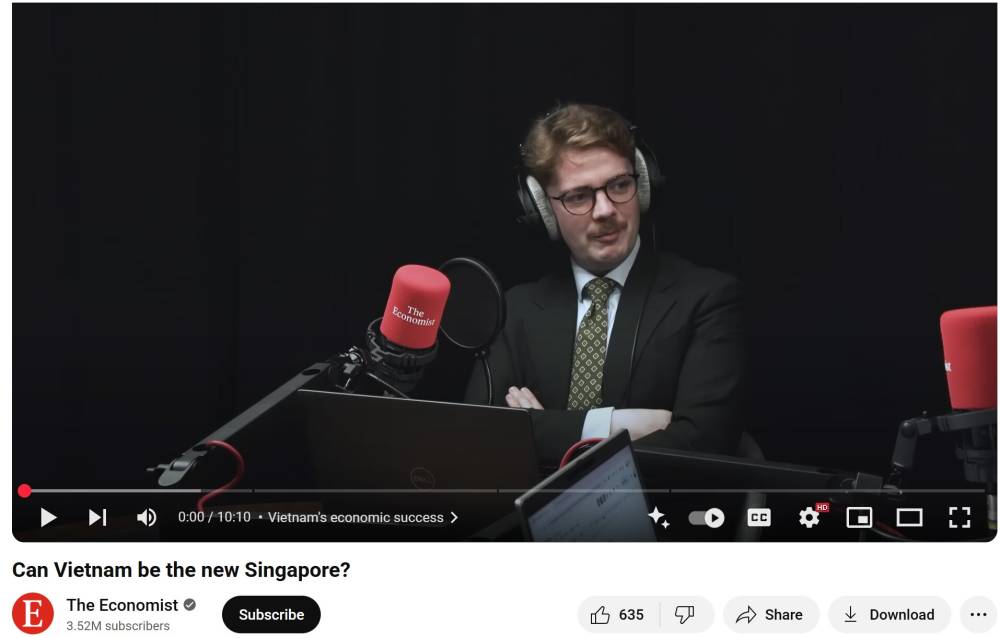
Podcast của Tạp chí The Economist: Việt Nam có thể trở thành “Singapore mới”?
-
Việt Nam đang thu hút sự chú ý toàn cầu nhờ tăng trưởng nhanh, mô hình xuất khẩu dựa trên đầu tư nước ngoài (FDI) và quan hệ ngoại giao khéo léo, đặc biệt với Mỹ trong bối cảnh căng thẳng thương mại.
-
Khoảng 30% GDP Việt Nam đến từ xuất khẩu sang Mỹ, phần lớn là hàng hóa được lắp ráp từ linh kiện nhập khẩu rồi xuất khẩu lại – mô hình này bị đe dọa nghiêm trọng nếu Mỹ áp thuế 46% như đề xuất từ phía ông Trump.
-
Trong nước, Tổng bí thư Tô Lâm đang thúc đẩy cải cách hành chính mạnh mẽ: giảm quy trình xin phép rườm rà, tăng cường tinh thần “chấp nhận rủi ro” trong đội ngũ công chức để hỗ trợ khu vực tư nhân.
-
Mục tiêu chiến lược là nâng tỷ trọng khu vực tư nhân từ 50% lên 70% GDP và tăng chi tiêu cho R&D – dấu hiệu cho thấy Đảng Cộng sản đang muốn thay đổi tư duy kinh tế theo hướng cởi mở hơn.
-
Tuy nhiên, mô hình dựa vào chi phí lao động thấp đang “giảm động lực”: lương tăng, lực lượng lao động nông thôn cạn dần, và Việt Nam bắt đầu mất lợi thế so với các nước như Ấn Độ, Bangladesh.
-
Nhiều tập đoàn lớn chỉ đến Việt Nam để hoàn tất giai đoạn lắp ráp, không chuyển giao công nghệ hay chuỗi cung ứng sâu cho doanh nghiệp nội địa – tạo ra tăng trưởng nhưng thiếu lan tỏa nội sinh.
-
So sánh với Trung Quốc, Việt Nam nhỏ hơn nhiều về quy mô thị trường và không thể phụ thuộc vào tiêu dùng nội địa để tự tăng trưởng. Điều này khiến mô hình của Việt Nam giống Singapore hơn: mở cửa hoàn toàn cho FDI và xây dựng thể chế ưu đãi doanh nghiệp ngoại.
-
Để giống Singapore, Việt Nam cần nâng tầm: yêu cầu FDI đào tạo nhân lực, tuyển dụng lãnh đạo bản địa, chuyển dần sang ngành có giá trị cao – điều Singapore đã làm rất thành công.
-
Nhưng thách thức là lớn: sản xuất giá trị cao như robot, bán dẫn đòi hỏi kỹ năng và máy móc, khó tạo việc làm đại trà cho 100 triệu dân. Dịch vụ và tiêu dùng nội địa có thể là hướng đi thay thế, nhưng cần chính sách hỗ trợ đồng bộ.
-
Việt Nam chỉ mới có khu vực tư nhân thực sự trong 30 năm, nhưng đã đạt nhiều thành tựu ngoạn mục. Tuy nhiên, bước tiếp theo để trở thành “Singapore mới” sẽ khó hơn – khi thế giới công nghiệp hóa ngày càng bão hòa và cạnh tranh khốc liệt.
📌 Việt Nam có tiềm năng trở thành “Singapore mới” nhờ chiến lược mở cửa FDI và cải cách thể chế, nhưng đang đối mặt nguy cơ suy giảm động lực nếu mô hình “lắp ráp giá rẻ” không chuyển mình. Mục tiêu tăng khu vực tư nhân lên 70% GDP và thúc đẩy công nghiệp giá trị cao là bước ngoặt sống còn để vượt khỏi bẫy thu nhập trung bình.
Can Vietnam be the new Singapore? - YouTube
https://www.youtube.com/watch?v=9uAKxTmCTcM
Transcript:
(00:00) why did you want to talk about Vietnam today vietnam is particularly interesting now uh you for for a variety of reasons you know I I think the first one that comes to mind is the intersection with tariffs with the US and with Trump world right so you know just in May uh the Trump Organization opened a new golf course not too far from Hanoi and you know uh that's part of a broader strategy in which you know Vietnam has been quite um savvy in uh dealing with America under Donald Trump uh Tolam the new uh general secretary of
(00:35) the communist party of Vietnam was one of the first phone calls uh that Donald Trump took after doing his liberation day tariffs um and you know that reflects kind of a a diplomatic savviness on the Vietnamese side but also the fact that Vietnam is so exposed to what America does on the tariffs front uh Vietnam's gotten rich with this uh foreign direct investment for export economic model uh you know in which a lot of the exports are eventually sold to America about 30% of GDP um about 30% of GDP is exports to the US
(01:08) uh these are products where the intermediate components are flown in from Korea or flown in from China assembled in Vietnam and then sold off primarily to American consumers and if Trump's imposing a 46% tariff as he's proposed on Vietnam that is a fundamental threat to that model just this week we had the conclusion of the third round of trade talks between Vietnam and the US uh supposedly they're making progress it looks to me pretty inconclusive but I I I think the trade is this the high level stuff that's
(01:37) catching the headlines but I think what's less understood is a lot of the stuff happening domestically within Vietnam and this is the place where Tolam has been the most radical has been the most ambitious uh he has proposed and begun enacting a massive restructuring of the Vietnamese bureaucracy which is this kind of you know sprawling apparatus it's got a bit of a license raj thing going on where uh it can be pretty hard to get your project approved in Vietnam um that was particularly true under the previous
(02:03) communist party secretary general uh who unleashed a massive anti-corruption campaign which had the effect of sort of scaring stiff the bureaucracy it was hard to get stuff approved a and you know Tolam who was involved in that anti-corruption campaign has come in and really changed the posture of the Vietnamese state to saying we're going to be a bit more tolerant of bureaucratic mistakes we want higher risk appetite right for you know in the Vietnamese bureaucracy to enable the private sector to to do more and not
(02:33) have to worry so much about regulation and focusing more on on doing good business that's a big departure for a a a party that historically has been focused on control focused on stability now they're talking about innovation they're talking about raising R&D spending economywide they're talking about lifting up the private sector from half of GDP to 70% of GDP which is a big departure again for um uh you know a party that has been lukewarm at best about the private sector so I you know I think that domestic story is is is a
(03:04) really big change in the past year and it reflects you know constraints that Vietnam's increasingly coming under on a variety of fronts yeah because there's a sense that maybe with the tariffs uh you know maybe this sort of export-led model and you know I encourage listeners to look it up because the the numbers on this in exports of GDP and stuff we think of you know Korea as a big exporter or or China as a big exporter Vietnam's on another level relative to the size of the domestic economy there seems to be a sort of sense that the
(03:31) even if this hasn't fully run out of steam even if there's something else still to be had you know some growth still to be had probably the best days are behind it that's exactly right part of the reason Vietnam was a attractive destination was low labor costs right you can do this you know relatively unsophisticated assembly with uh Vietnamese workers who are hardworking by all accounts uh relatively healthy and educated on kind of basic uh human development metrics you know compared to peer countries and you know most
(03:59) importantly a fourth the labor costs of China right and so you know that was part of that was the the fundamental factor in the model then you put on top of that tax breaks you know um tax breaks land access other kind of state incentives uh for foreign companies to come in and what you had is big multinationals saw Vietnam as a great place to do the final stage of manufacturing the assembly process right one issue with that is domestic Vietnamese businesses are not really getting in on that game right they're
(04:30) coming and taking advantage of the labor costs uh to do this pretty simple step and there's not a lot of Vietnamese suppliers the the the goods are coming from elsewhere and this is not a model that can really thrive if you have rising labor costs as Vietnam has had um what they've done is over the years is channel rural labor surpluses from the countryside into the cities into the factories that's a model familiar in other countries too like in China but that's starting to lose steam you know in the latest data uh agricultural job
(05:00) destruction which is you know sort of a sign of modernization that's slowed down pretty significantly and we've seen you know several decades of of rising wages it's now competitive to or above other pure countries like India um you know above you know poorer countries like Bangladesh or Cambodia and you know the issue with that is how does Vietnam get from where it is now you know lower middle income but dynamic and growing to that upper middle that upper middle income and eventually upper income status that it wants to achieve the
(05:30) official goal is by 2045 there's no way of explaining Vietnam's growth that shouldn't start with the the sort of the fact that this has been astounding most other countries would you know uh skin their mothers to to get this sort of economic performance and this sort of extremely rapid development but it does feel like these things are sort of tapping out a little bit one thing I always liked when I was covering this is that if you look at listed Vietnamese companies they perform absolutely terribly it's like in terms of the
(05:59) companies that you'd have access to as a as a public markets investor if you'd invested in Vietnam you would have seen none of this growth it's been absolutely terrible awful awful time which again brings us back to the the comparison with China which has a very very similar problem and I find all of this interesting um largely because similar political model to China in some ways it's a communist party it comes with all of the difficulties of running a private sector economy and keeping a sort of authoritarian top- down political system
(06:27) that was designed for a very different sort of uh economic structure but it's also very different to China in that in China uh 15 times the size by population or thereabouts um you could rely to some degree on a domestic market right this is much more difficult in in Vietnam than it is uh in China um not just because the income levels are low but because in absolute terms 100 million people it's not all that many the market size is never going to be absolutely enormous and I think that's actually what makes sometimes I think the the
(07:00) economic model looks more like Singapore than it does like China in that they've gone all in on the foreign direct investment model and they've said no barnacles on the boat we'll give you you we'll get you land we'll set you up in the industrial park we'll we'll sort things out for you we'll find you workers we'll do everything we can and sort of trying to turn away from this is like yeah really trying to turn the ship around all at once um it will be really interesting to see whether they can do it and and I think also to some degree
(07:27) whether they can pull off what Singapore's done which is to try and pull higher and higher value added stuff from the foreign direct investment so you know in Singapore there's uh there's sort of rules around if you're a foreign investing company you have to hire a certain number of Singaporeans that's not a problem for Vietnam but maybe they want to say we want x number of more senior management positions we want you to train a certain number of people in in certain new skills whether there are things they can do around that I don't
(07:57) know but um but yeah I'm very interested to see how it plays out i I think it's arguably harder for a middle- inome country these days to climb the development ladder given the global environment we have right those high-end sophisticated industries are already dominated by like the Asian tigers and by by China right and it's not like they're going away uh you know when when Korea industrialized uh there were niches that it could carve out and and you know there were things available in in in Vietnam you know they they have to
(08:27) try to capitalize on new and emerging technologies uh from a lower baseline you know the reason that so many people that study Vietnam adopt this baseline attitude of optimism is just the trajectory so far right we have to remember that this is a country that literally did not have a private se a formal private sector uh before the 1980s and even then really not much to speak of until well into the 1990s so it's had less than three decades to really you know build have have compounding and you know building on a
(08:56) base of private sector you know developing industrial networks and so on and so forth but you know something you've written about Mike that I I think is interesting is in in a world where developing through manufacturing has gotten harder and harder you know what can you do that will generate employment for your uh 100 million people right and so this is is a big difference with Singapore singapore doesn't really have like a rural hinterland where you need to find jobs for you know a large swath of of people you know in in Vietnam the
(09:27) the factories helped in this way you could migrate from the countryside to the cities and get employment and if that model's losing steam are there services that can replace that and absorb that labor are there you know can advanced manufacturing which probably is going to rely on robotics and and advanced industrial processes really employ a broad swath of of people in your country and so I think you know uh we we have to think about a domestic consumption economy and and how to build that to me these are open development
(09:57) questions where there's not super convincing answers and I I I I think that's obviously a bigger challenge than just in Vietnam but it's one that definitely looms large [Music]
Thảo luận
Follow Us
Tin phổ biến



